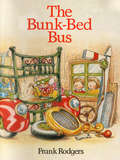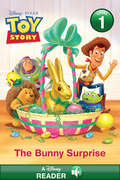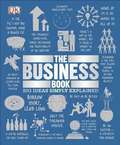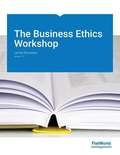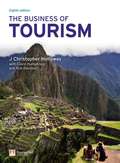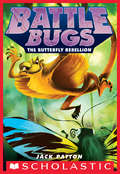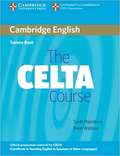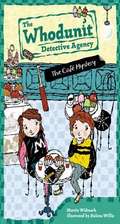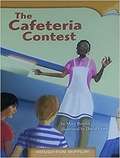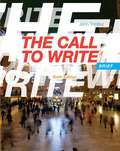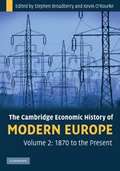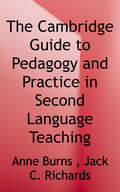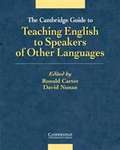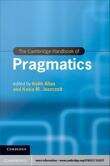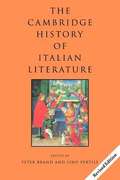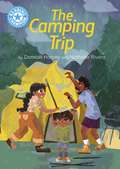- Table View
- List View
The Bunk-Bed Bus
by Frank RodgersIncluded in the the original Standard Attainment Tests book list for English schoolsJanet and Sam have the most dynamic granny you’ve ever met. She goes jogging, builds shelves and fixes cars - and when a snooty neighbour tells her she’s not artistic she’s determined to prove her wrong. Granny sets to work and creates a wonderful iron sculpture for the art exhibition. The local children think it’s great - but what will the judges think of the amazing bunk-bed bus?Just perfect for beginner readers.
The Bunny Surprise (Toy Story)
by Disney PressBuzz Lightyear, Sheriff Woody, and the rest of the toys from Disney/Pixar Toy Story are back for an Easter adventure! Kids ages 4-6 will love learning to read with this Step 1 Step into Reading reader.
The Bunny-hop Hoax (Nancy Drew Notebooks #64)
by Carolyn Keene Michael Frost Jan Naimo JonesNancy's friends are sad because the class hamster has gone missing. Poor Nibbles. But then Katie brings in a bunny named Bun Franklin to be the new class pet! Everyone is thrilled, and now they can began preparing for the Spring Fair. But soon enough someone starts wrecking the class's Spring Fair projects, and everyone thinks it must be Bun Franklin! Mrs. Reynolds is afraid he can't stay. But Nancy is sure it's not Bun--how can she prove it? It takes a lot of clue hunting and sleuthing for Nancy to realize that what she's uncovered just may solve two mysteries at once!
The Bus Stop (Fountas & Pinnell Classroom, Guided Reading)
by Stephen Stone Michelle BeachNIMAC-sourced textbook
The Business Book
by Dorling Kindersley Publishing StaffFrom the time that goods and services began to be traded in early civilizations, people have been thinking about business. The emergence of specialized producers and the use of money as a means of exchange were methods by which individuals and societies could, in modern terms, gain a "business edge." The ancient Egyptians, the Mayans, the Greeks, and the Romans all knew that wealth creation through the mechanism of commerce was fundamental to the acquisition of power, and formed the base on which civilization could prosper.
The Business Ethics Workshop v 1.0
by James BrusseauOn a good day in the business ethics classroom discussion charges forward; students have read the assigned case study, they’re engaged by the conflict and want to work through it. Then, there’s a bad day: students didn’t bother to do the reading and the hour sags listlessly. The key to going the first way is case studies that students want to read, and The Business Ethics Workshop by James Brusseau provides them with reality and engagement. Reality: No stilted and contrived stories about Steve Smith and Jane Jones. Excerpts from blogs and newspapers bring the weight—and provocation—of the world as it’s actually happening to the classroom.
The Business Ethics Workshop v 1.0
by James BrusseauOn a good day in the business ethics classroom discussion charges forward; students have read the assigned case study, they're engaged by the conflict and want to work through it. Then, there's a bad day: students didn't bother to do the reading and the hour sags listlessly. The key to going the first way is case studies that students want to read, and The Business Ethics Workshop by James Brusseau provides them with reality and engagement. Reality: No stilted and contrived stories about Steve Smith and Jane Jones. Excerpts from blogs and newspapers bring the weight--and provocation--of the world as it's actually happening to the classroom.
The Business of Tourism
by Chris Holloway R. Davidson Claire HumphreysAn invaluable foundation book for Tourism or Tourism Management students, Holloway et al offers historical context, background theory and current research, making it possible for students to see how the industry has developed and to contextualise the current issues and challenges that Tourism is facing today. Holloway et al place emphasis on the practical operational aspects of the tourism industry, making this book well-suited to students who intend to one day work in Tourism.
The Butterfly Rebellion (Battle Bugs #9)
by Jack PattonNever leave a bug behind -- Collect all the Battle Bugs books!Look out below!Gliding lizards have taken Bug Island by storm, and the Battle Bugs need Max's help. Fortunately, Max has the perfect plan up his sleeve.To fight the lizards, the bugs will have to take to the air. Max has to organize the butterfly squadrons before their homeland is completely overrun!
The CELTA Course Trainee Book
by Scott ThornburyThe CELTA Course is the only CELTA preparation course endorsed by Cambridge ESOL. It provides full coverage of the CELTA syllabus in a ready-to-use course. The CELTA Course is divided into user-friendly sections: * Input sessions (40 units on 'The learners and their contexts', 'Classroom teaching', 'Language awareness', and 'Professional development') * Teaching practice * Classroom observation * Written assignments and tutorials * 'Resource file' The Trainee Book includes a range of material to be used in input sessions, helpful advice about the course, and a wealth of useful reference material. The Trainer's Manual includes suggestions on how to best use the material with trainees, as well as help and advice on how to prepare trainees for teaching practice, lesson observations, written assessment and tutorials.
The Cafe Mystery #4
by Martin Widmark Helena WillisJerry and Maya, classmates and best friends, are on the case again and ready to solve the latest caper in this international best-selling series.A robber has struck at Cafe Marzipan, Pleasant Valley's best bakery, three times in the past year! And as usual, the police chief has no clue as to who the clever culprit might be. Once again, he calls upon the super sleuthing skills of best friends Jerry and Maya to help him catch the tricky thief. Will they be able to look past the muffins, croissants, and tarts and catch the robber?
The Cafeteria Contest (Houghton Mifflin Leveled Books #Level 1, Book 1)
by David Lowe Mary BendixNIMAC-sourced textbook <p><p> This is Grade 5, Level 1, Book 1 in the Houghton Mifflin Leveled Books series. The book info is as follows: Level: O / DRA: 38 / Genre: Humorous Fiction / Strategy: Summarize / Skill: Story Structure / Word Count: 1,286
The Call that Started It All (Fountas & Pinnell Classroom, Guided Reading Grade 5)
by Suzanne SladeThe Day Everything Changed It's getting dark and you need a ride. If it's 1973, you go to a pay phone, drop in some change, and call home. Today you make a call on a phone you carry with you and all you need to worry about is a dead battery. NIMAC-sourced textbook
The Call to Write (Brief Sixth Edition)
by John TrimburThe brief sixth edition of THE CALL TO WRITE continues and expandes its creative approach to college composition. Organized by genres, including letters, memoirs, profiles, reports, commentaries, proposals, and reviews, and including new chapters on the essay and on multigenre writing, this innovative rhetoric gives students the practice they need to write in college and in the public sphere. Timely, provocative readings promote social engagement, encouraging students to become involved, through public writing, in their community and in the greater world around them.
The Cambridge Companion to Narrative
by David HermanThe Cambridge Companion to Narrative provides a unique and valuable overview of current approaches to narrative study. An international team of experts explores ideas of storytelling and methods of narrative analysis as they have emerged across diverse traditions of inquiry and in connection with a variety of media, from film and television, to storytelling in the 'real-life' contexts of face-to-face interaction, to literary fiction. Each chapter presents a survey of scholarly approaches to topics such as character, dialogue, genre or language, shows how those approaches can be brought to bear on a relatively well-known illustrative example, and indicates directions for further research. Featuring a chapter reviewing definitions of narrative, a glossary of key terms and a comprehensive index, this is an essential resource for both students and scholars in many fields, including language and literature, composition and rhetoric, creative writing, jurisprudence, communication and media studies, and the social sciences.
The Cambridge Economic History of Modern Europe, Volume 2: 1870 to the Present
by Kevin H. O'Rourke Stephen BroadberryUnlike most existing textbooks on the economic history of modern Europe, which offer a country-by-country approach, The Cambridge Economic History of Modern Europe rethinks Europe's economic history since 1700 as unified and pan-European, with the material organized by topic rather than by country. This second volume tracks Europe's economic history through three major phases since 1870. The first phase was an age of globalization and of European economic and political dominance that lasted until the First World War. The second, from 1914 to 1945, was one of war, deglobalization, and depression and the third was one of growing integration not only within Europe but also between Europe and the global economy. Leading authors offer comprehensive and accessible introductions to these patterns of globalization and deglobalization as well as to key themes in modern economic history such as economic growth, business cycles, sectoral developments, and population and living standards.
The Cambridge Guide to Pedagogy and Practice in Second Language Teaching
by Jack C. Richards Anne BurnsThis collection of original articles provides a state-of-the-art overview of key issues and approaches in contemporary language teaching. <p><p>Written by internationally prominent researchers, educators, and emerging scholars, the chapters are grouped into five sections: rethinking our understanding of teaching, learner diversity and classroom learning, pedagogical approaches and practices, components of the curriculum, and media and materials. <p><p>Each chapter covers key topics in teaching methodology such as reflective pedagogy, teaching large classes, outcomes-based language learning, speaking instruction, and technology in the classroom. Chapters assume no particular background knowledge and are written in an accessible style.
The Cambridge Guide to Teaching English to Speakers of Other Languages
by Ronald CarterThis important book, with 32 chapters by leading figures in the field, is an up-to-date guide to the central areas of applied linguistics and language studies with particular reference to TESOL. It looks at the current state of TESOL as well as at what is likely to happen in the future.
The Cambridge Handbook Of Personality Psychology (Cambridge Handbooks In Psychology)
by Gerald Matthews Philip J. CorrResearch on personality psychology is making important contributions to psychological science and applied psychology. This second edition of The Cambridge Handbook of Personality Psychology offers a one-stop resource for scientific personality psychology. It summarizes cutting-edge personality research in all its forms, including genetics, psychometrics, social-cognitive psychology, and real-world expressions, with informative and lively chapters that also highlight some areas of controversy. The team of renowned international authors, led by two esteemed editors, ensures a wide range of theoretical perspectives. Each research area is discussed in terms of scientific foundations, main theories and findings, and future directions for research. The handbook also features advances in technology, such as molecular genetics and functional neuroimaging, as well as contemporary statistical approaches. An invaluable aid to understanding the central role played by personality in psychology, it will appeal to students, researchers, and practitioners in psychology, behavioral neuroscience, and the social sciences.
The Cambridge Handbook of Pragmatics
by Kasia M. Jaszczolt Keith AllanPragmatics is the study of human communication: the choices speakers make to express their intended meaning and the kinds of inferences that hearers draw from an utterance in the context of its use. This Handbook surveys pragmatics from different perspectives, presenting the main theories in pragmatic research, incorporating seminal research as well as cutting-edge solutions. It addresses questions of rational and empirical research methods, what counts as an adequate and successful pragmatic theory, and how to go about answering problems raised in pragmatic theory. In the fast-developing field of pragmatics, this Handbook fills the gap in the market for a one-stop resource to the wide scope of today's research and the intricacy of the many theoretical debates. It is an authoritative guide for graduate students and researchers with its focus on the areas and theories that will mark progress in pragmatic research in the future.
The Cambridge History Of Italian Literature
by Peter Brand Lino PertileItaly possesses one of the richest and most influential literatures of Europe, stretching back to the thirteenth century. This substantial history of Italian literature provides a comprehensive survey of Italian writing since its earliest origins. Leading scholars describe and assess the work of writers who have contributed to the Italian literary tradition, including Dante, Petrarch and Boccaccio, the Renaissance humanists, Machiavelli, Ariosto and Tasso, pioneers and practitioners of commedia dell'arte and opera, and the contemporary novelists Calvino and Eco. The Cambridge History of Italian Literature sets out to be accessible to the general reader as well as to students and scholars: translations are provided, along with a map, chronological chart and substantial bibliographies.
The Cambridge Illustrated History of China
by Patricia Buckley EbreyMore populous than any other country on earth, China also occupies a unique place in our modern world for the continuity of its history and culture. In this sumptuously illustrated single-volume history, now in its second edition, noted historian Patricia Buckley Ebrey traces the origins of Chinese culture from prehistoric times to the present. She follows its development from the rise of Confucianism, Buddhism, and the great imperial dynasties to the Mongol, Manchu, and Western intrusions and the modern communist state. Her scope is phenomenal - embracing Chinese arts, culture, economics, society and its treatment of women, foreign policy, emigration, and politics, including the key uprisings of 1919 and 1989 in Tiananmen Square. Both a comprehensive introduction to an extraordinary civilization and an expert exploration of the continuities and disjunctures of Chinese history, Professor Ebrey's book has become an indispensable guide to China past and present. This second edition includes a new chapter on China's recent opening to the world and a fully revised guide to further reading.
The Camping Trip
by Marcie Aboff Solana PaganThe fun and excitement of English and Language Arts learning continues in Grade 2 of Reading Street. This comprehensive and dynamic curriculum for homeschooling is geared toward young children who have some foundational English and Language Arts knowledge and are ready to strengthen their skills. Comprised of engaging activities, challenging content and weekly quizzes, Reading Street: Grade 2 is the next step in your child's path toward becoming a lifelong learner and reader. As with all Reading Street products, the Grade 2 system is formatted to help students meet certain age-appropriate goals. After completing this English and Language Arts homeschool program, your child should be able to: Read and comprehend two-syllable words. Identify common prefixes (such as pre-, un-, or re-) and suffixes (such as -able, -ad and -er). Correct mistakes made when reading out loud. Read books with two or more chapters. Understand the structure of stores (i. e. beginning, middle and end). Start selecting reading materials based on his/her own interests. Identify the "who," "what," "when," "where," "why" and "how" of the text. While the goals of second Grade English and Language Arts are numerous, Reading Street will help you craft engrossing lessons. Your child will garner important English and Language Arts skills while completing a workbook, reading stories and poems, and taking assessments. Planning these lessons will be easier than ever, as all Reading Street systems are broken down into weekly Big Ideas. All the work your child does on a given week is formulated around that single concept for an organized and challenging curriculum. With six easy-to-follow units, Reading Street: Grade 2 is the perfect tool for homeschooling parents. Your child will enjoy the reading selections and activities, and you'll love to see your student growing into a knowledgeable individual. We're confident that this product is the right one for you. For more information on the specific materials found in Grade 2 of Reading Street, check out the Features and Benefits page.
The Camping Trip: Arctic Adventures Chapter Book Set (Artic Adventures Chapter Series)
by Michèle DufresneNIMAC-sourced textbook
The Camping Trip: Independent Reading Blue 4 (Reading Champion #587)
by Damian HarveyThis story is part of Reading Champion, a series carefully linked to book bands to encourage independent reading skills, developed with Dr Sue Bodman and Glen Franklin of UCL Institute of Education (IOE)Mum and Dad want to go camping, but everything keeps going wrong, and Nish isn't keen on it ... will they go camping after all?Reading Champion offers independent reading books for children to practise and reinforce their developing reading skills.Fantastic, original stories are accompanied by engaging artwork and a reading activity. Each book has been carefully graded so that it can be matched to a child's reading ability, encouraging reading for pleasure.Perfect for 5-6 year olds or those reading book band blue 4.
